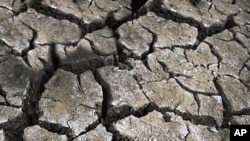As many Somali refugees flee to Kenya to escape the harsh drought in their homeland, parts of Kenya itself are facing severe shortages of food and water.
The humanitarian agency ActionAid is appealing for nearly $2.5 million for its relief operations in Kenya and elsewhere in East Africa.
“The situation in Kenya is quite, quite bad. Right now, we are talking about 3.5 million Kenyans who are in a humanitarian crisis. And there is increasing hunger and malnutrition, particularly for children and lactating women,” said Philip Kilonzo is ActionAid’s national right to food coordinator in Nairobi.
Many communities in Northeastern and Eastern provinces and northern Rift Valley Province don’t have any water.
“In some places, ActionAid is actually doing some water trucking to meet the basic needs for the people who are with no water,” he said.
Conservative estimate
“According to the Kenya Food Security Steering Group report,” said Kilonzo, “basically all those areas right now are in a humanitarian crisis. And of course government reports are usually very reserved reports. When they say it’s a humanitarian crisis, please note the situation has extremely deteriorated.”
Kilonzo recently visited drought-stricken areas and saw no smoke coming from the dwellings, indicating families had no food to cook. Two families said they were going to the nearby shop to “pledge some food” so they could eat.
“That was quite shocking,” he said, “It made me contribute my own money to just meet their immediate needs.”
Food vs. water
Many families are faced with the question: Is it better to eat or drink?
“Water is really a big, big issue. Given a priority between food and water, the communities are actually prioritizing water. And this is happening in so many places.
One sign of how bad drought conditions are is evidence that people are eating seeds for food, leaving none to plant, and selling off livestock for food money.
“Actually, right now, we are not talking about seeds. Given a choice between preserving seed and eating to survive, then you would rather eat and maybe let the future take care of itself. So right now, most of the communities in the areas that I’ve described have no single grain that they can actually call seeds,” he said.
As for livestock, Kilonzo met one woman in a market place, who was selling her donkey at half the normal going price.
“Donkeys are usually used a pack animals. She had depleted all the goats and the sheep and now she was selling a donkey,” he said.
Residents told the ActionAid official that they needed either humanitarian assistance or jobs to earn money to buy food. “The local economies are not only collapsing, but food shortages are worsening the situation further,” he said.
Immediate needs
ActionAid already knows how the nearly $2.5 million will be spent once the appeal is met.
“We know right now men who have actually gone mad and we know children have now begun dropping out of school. So meeting the humanitarian imperative, which is actually providing food, becomes quite important. But much more so important is trying to ensure that we rehabilitate the water structures [that] these communities rely on,” he said
The NGO will also provide seeds to farmers. “Because come next rainy season they will have nothing to plant,” he said, “Meeting the basic, basic needs. That will be our priority.”
In a statement, ActionAid said, “As is often the case with slow onset disasters, such as drought…the international community has been slow to provide sufficient funding for a humanitarian response.”
Other humanitarian agencies have issued appeals, as well, to deal with the East Africa drought.










